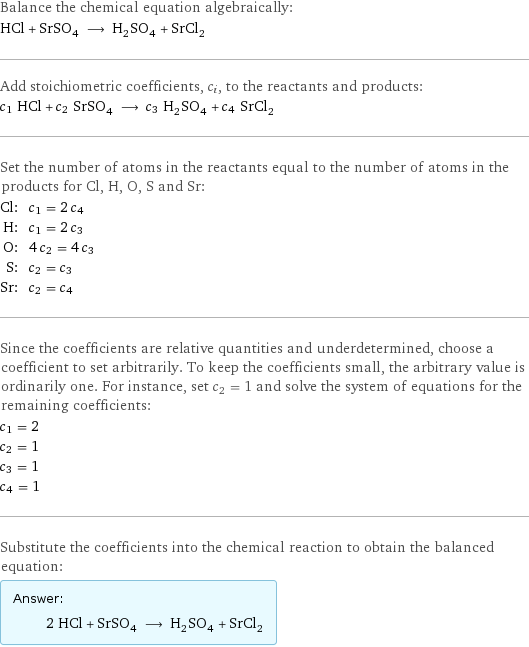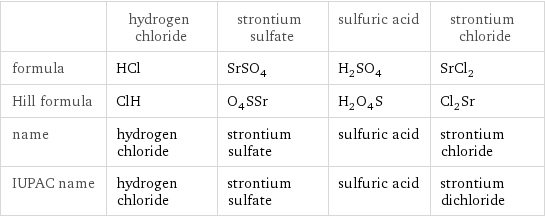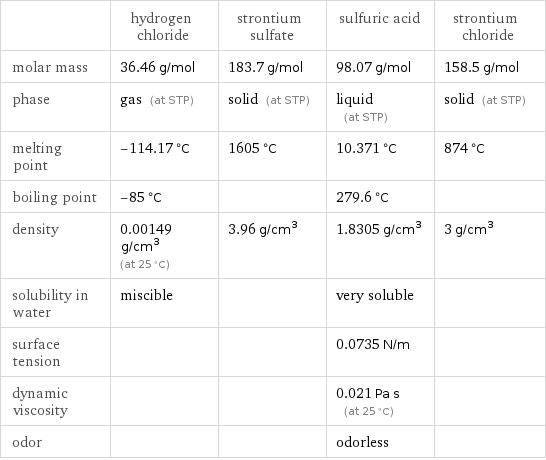Input interpretation

HCl hydrogen chloride + SrSO_4 strontium sulfate ⟶ H_2SO_4 sulfuric acid + SrCl_2 strontium chloride
Balanced equation

Balance the chemical equation algebraically: HCl + SrSO_4 ⟶ H_2SO_4 + SrCl_2 Add stoichiometric coefficients, c_i, to the reactants and products: c_1 HCl + c_2 SrSO_4 ⟶ c_3 H_2SO_4 + c_4 SrCl_2 Set the number of atoms in the reactants equal to the number of atoms in the products for Cl, H, O, S and Sr: Cl: | c_1 = 2 c_4 H: | c_1 = 2 c_3 O: | 4 c_2 = 4 c_3 S: | c_2 = c_3 Sr: | c_2 = c_4 Since the coefficients are relative quantities and underdetermined, choose a coefficient to set arbitrarily. To keep the coefficients small, the arbitrary value is ordinarily one. For instance, set c_2 = 1 and solve the system of equations for the remaining coefficients: c_1 = 2 c_2 = 1 c_3 = 1 c_4 = 1 Substitute the coefficients into the chemical reaction to obtain the balanced equation: Answer: | | 2 HCl + SrSO_4 ⟶ H_2SO_4 + SrCl_2
Structures

+ ⟶ +
Names

hydrogen chloride + strontium sulfate ⟶ sulfuric acid + strontium chloride
Reaction thermodynamics
Enthalpy

| hydrogen chloride | strontium sulfate | sulfuric acid | strontium chloride molecular enthalpy | -92.3 kJ/mol | -1453 kJ/mol | -814 kJ/mol | -828.9 kJ/mol total enthalpy | -184.6 kJ/mol | -1453 kJ/mol | -814 kJ/mol | -828.9 kJ/mol | H_initial = -1638 kJ/mol | | H_final = -1643 kJ/mol | ΔH_rxn^0 | -1643 kJ/mol - -1638 kJ/mol = -5.2 kJ/mol (exothermic) | | |
Gibbs free energy

| hydrogen chloride | strontium sulfate | sulfuric acid | strontium chloride molecular free energy | -95.3 kJ/mol | -1341 kJ/mol | -690 kJ/mol | -781.1 kJ/mol total free energy | -190.6 kJ/mol | -1341 kJ/mol | -690 kJ/mol | -781.1 kJ/mol | G_initial = -1532 kJ/mol | | G_final = -1471 kJ/mol | ΔG_rxn^0 | -1471 kJ/mol - -1532 kJ/mol = 60.4 kJ/mol (endergonic) | | |
Equilibrium constant
![Construct the equilibrium constant, K, expression for: HCl + SrSO_4 ⟶ H_2SO_4 + SrCl_2 Plan: • Balance the chemical equation. • Determine the stoichiometric numbers. • Assemble the activity expression for each chemical species. • Use the activity expressions to build the equilibrium constant expression. Write the balanced chemical equation: 2 HCl + SrSO_4 ⟶ H_2SO_4 + SrCl_2 Assign stoichiometric numbers, ν_i, using the stoichiometric coefficients, c_i, from the balanced chemical equation in the following manner: ν_i = -c_i for reactants and ν_i = c_i for products: chemical species | c_i | ν_i HCl | 2 | -2 SrSO_4 | 1 | -1 H_2SO_4 | 1 | 1 SrCl_2 | 1 | 1 Assemble the activity expressions accounting for the state of matter and ν_i: chemical species | c_i | ν_i | activity expression HCl | 2 | -2 | ([HCl])^(-2) SrSO_4 | 1 | -1 | ([SrSO4])^(-1) H_2SO_4 | 1 | 1 | [H2SO4] SrCl_2 | 1 | 1 | [SrCl2] The equilibrium constant symbol in the concentration basis is: K_c Mulitply the activity expressions to arrive at the K_c expression: Answer: | | K_c = ([HCl])^(-2) ([SrSO4])^(-1) [H2SO4] [SrCl2] = ([H2SO4] [SrCl2])/(([HCl])^2 [SrSO4])](../image_source/89d5395520c96fd07f77a6a3c5a59e75.png)
Construct the equilibrium constant, K, expression for: HCl + SrSO_4 ⟶ H_2SO_4 + SrCl_2 Plan: • Balance the chemical equation. • Determine the stoichiometric numbers. • Assemble the activity expression for each chemical species. • Use the activity expressions to build the equilibrium constant expression. Write the balanced chemical equation: 2 HCl + SrSO_4 ⟶ H_2SO_4 + SrCl_2 Assign stoichiometric numbers, ν_i, using the stoichiometric coefficients, c_i, from the balanced chemical equation in the following manner: ν_i = -c_i for reactants and ν_i = c_i for products: chemical species | c_i | ν_i HCl | 2 | -2 SrSO_4 | 1 | -1 H_2SO_4 | 1 | 1 SrCl_2 | 1 | 1 Assemble the activity expressions accounting for the state of matter and ν_i: chemical species | c_i | ν_i | activity expression HCl | 2 | -2 | ([HCl])^(-2) SrSO_4 | 1 | -1 | ([SrSO4])^(-1) H_2SO_4 | 1 | 1 | [H2SO4] SrCl_2 | 1 | 1 | [SrCl2] The equilibrium constant symbol in the concentration basis is: K_c Mulitply the activity expressions to arrive at the K_c expression: Answer: | | K_c = ([HCl])^(-2) ([SrSO4])^(-1) [H2SO4] [SrCl2] = ([H2SO4] [SrCl2])/(([HCl])^2 [SrSO4])
Rate of reaction
![Construct the rate of reaction expression for: HCl + SrSO_4 ⟶ H_2SO_4 + SrCl_2 Plan: • Balance the chemical equation. • Determine the stoichiometric numbers. • Assemble the rate term for each chemical species. • Write the rate of reaction expression. Write the balanced chemical equation: 2 HCl + SrSO_4 ⟶ H_2SO_4 + SrCl_2 Assign stoichiometric numbers, ν_i, using the stoichiometric coefficients, c_i, from the balanced chemical equation in the following manner: ν_i = -c_i for reactants and ν_i = c_i for products: chemical species | c_i | ν_i HCl | 2 | -2 SrSO_4 | 1 | -1 H_2SO_4 | 1 | 1 SrCl_2 | 1 | 1 The rate term for each chemical species, B_i, is 1/ν_i(Δ[B_i])/(Δt) where [B_i] is the amount concentration and t is time: chemical species | c_i | ν_i | rate term HCl | 2 | -2 | -1/2 (Δ[HCl])/(Δt) SrSO_4 | 1 | -1 | -(Δ[SrSO4])/(Δt) H_2SO_4 | 1 | 1 | (Δ[H2SO4])/(Δt) SrCl_2 | 1 | 1 | (Δ[SrCl2])/(Δt) (for infinitesimal rate of change, replace Δ with d) Set the rate terms equal to each other to arrive at the rate expression: Answer: | | rate = -1/2 (Δ[HCl])/(Δt) = -(Δ[SrSO4])/(Δt) = (Δ[H2SO4])/(Δt) = (Δ[SrCl2])/(Δt) (assuming constant volume and no accumulation of intermediates or side products)](../image_source/627cfbd386d9b2062815efa6ef07c874.png)
Construct the rate of reaction expression for: HCl + SrSO_4 ⟶ H_2SO_4 + SrCl_2 Plan: • Balance the chemical equation. • Determine the stoichiometric numbers. • Assemble the rate term for each chemical species. • Write the rate of reaction expression. Write the balanced chemical equation: 2 HCl + SrSO_4 ⟶ H_2SO_4 + SrCl_2 Assign stoichiometric numbers, ν_i, using the stoichiometric coefficients, c_i, from the balanced chemical equation in the following manner: ν_i = -c_i for reactants and ν_i = c_i for products: chemical species | c_i | ν_i HCl | 2 | -2 SrSO_4 | 1 | -1 H_2SO_4 | 1 | 1 SrCl_2 | 1 | 1 The rate term for each chemical species, B_i, is 1/ν_i(Δ[B_i])/(Δt) where [B_i] is the amount concentration and t is time: chemical species | c_i | ν_i | rate term HCl | 2 | -2 | -1/2 (Δ[HCl])/(Δt) SrSO_4 | 1 | -1 | -(Δ[SrSO4])/(Δt) H_2SO_4 | 1 | 1 | (Δ[H2SO4])/(Δt) SrCl_2 | 1 | 1 | (Δ[SrCl2])/(Δt) (for infinitesimal rate of change, replace Δ with d) Set the rate terms equal to each other to arrive at the rate expression: Answer: | | rate = -1/2 (Δ[HCl])/(Δt) = -(Δ[SrSO4])/(Δt) = (Δ[H2SO4])/(Δt) = (Δ[SrCl2])/(Δt) (assuming constant volume and no accumulation of intermediates or side products)
Chemical names and formulas

| hydrogen chloride | strontium sulfate | sulfuric acid | strontium chloride formula | HCl | SrSO_4 | H_2SO_4 | SrCl_2 Hill formula | ClH | O_4SSr | H_2O_4S | Cl_2Sr name | hydrogen chloride | strontium sulfate | sulfuric acid | strontium chloride IUPAC name | hydrogen chloride | strontium sulfate | sulfuric acid | strontium dichloride
Substance properties

| hydrogen chloride | strontium sulfate | sulfuric acid | strontium chloride molar mass | 36.46 g/mol | 183.7 g/mol | 98.07 g/mol | 158.5 g/mol phase | gas (at STP) | solid (at STP) | liquid (at STP) | solid (at STP) melting point | -114.17 °C | 1605 °C | 10.371 °C | 874 °C boiling point | -85 °C | | 279.6 °C | density | 0.00149 g/cm^3 (at 25 °C) | 3.96 g/cm^3 | 1.8305 g/cm^3 | 3 g/cm^3 solubility in water | miscible | | very soluble | surface tension | | | 0.0735 N/m | dynamic viscosity | | | 0.021 Pa s (at 25 °C) | odor | | | odorless |
Units
